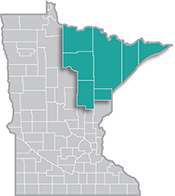 Home to the state's second-largest metro, the Northeast Region has a strong industrial sector, tied largely to the area's abundant natural resources.
Home to the state's second-largest metro, the Northeast Region has a strong industrial sector, tied largely to the area's abundant natural resources.
Most of the manufacturing base centers on mining and forest products industries. More than half of the sector's employment is in paper and machinery manufacturing.
Want the freshest data delivered by email? Subscribe to our regional newsletters.
2/26/2016 12:04:56 PM
Erik White
As part of the implementation of the new Workforce Innovation and Opportunity Act (WIOA), Minnesota is working on a combined state plan to consider challenges and opportunities that exist in the workforce development system. The plan’s vision statement is:
To have a healthy economy where all Minnesotans have – or are on a path to – meaningful employment and a family-sustaining wage, and where all employers are able to fill jobs in demand.
For this Local Look post, we will focus on the family-sustaining wage aspect and analyze what that looks like for Northeast Minnesota.
DEED’s Cost of Living data tool provides a guideline for how much it costs to live in Minnesota by providing a yearly estimate of the basic needs for individuals and families by county, region and state. Utilizing federal and state data, costs are estimated for seven categories: food, housing, health care, transportation, child care, other necessities and net taxes. The total costs from these categories represent neither poverty-level living nor a middle class living, but rather a simple living standard that meets basic needs for health and safety. It does not include costs associated with savings, vacations, entertainment and more.
In Northeast Minnesota, the typical family – which consists of a partnered couple with 1 full-time and 1 part-time worker, and one child – has a yearly basic cost of living of $43,560. To provide for their basic needs, an hourly wage of $13.96 would be needed for both the full-time and part-time worker of this family unit.
For a single full-time worker with no children, a wage of $10.52 would be enough to provide for their basic needs; while a single full-time worker with two children would need a wage of $24.40 to provide for the health and safety of their family. For a family of five with two full-time workers and three children, an hourly wage of $15.20 would be needed by both wage earners (Table 1).

Not only does the cost of living fluctuate based on family size and makeup, but the amount needed to sustain the basic needs of the family depends on the region of the state they live in. As shown in Northeast Minnesota, the yearly cost of $43,560 is estimated for a typical family, partnered with one full-time and one part-time worker, with one child.
That is considerably less than the $55,896 cost of living estimated for a typical family residing in the seven-county Twin Cities metro area. An hourly wage of $17.92 is required to meet that cost of living. Child care, housing, and taxes are all considerably greater in the Twin Cities area than they are in Northeast, which is reflected across the data tool results. In fact, the Arrowhead region has the third lowest cost of living of the six planning regions in the state (Table 2). While not presented here, the Cost of Living tool also shows estimates for all 87 counties in Minnesota.

With Minnesota’s emphasis on family-sustaining wages in its coordination with WIOA, the cost of living becomes an important factor. DEED’s Cost of Living tool provides estimates for basic needs based on different family arrangements and locations. This information can be helpful to highlight the opportunities and challenges that exist in the workforce development system, which we will continue to monitor.
Contact Erik White at 218-302-8413.